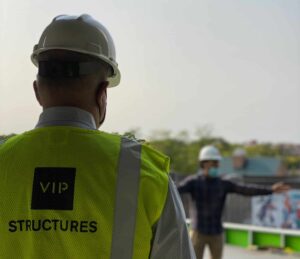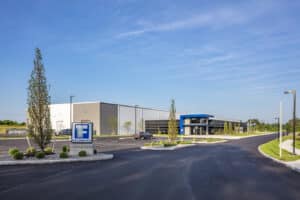Have you ever received an impressive building design, but then you saw the cost and did a double-take? Was there an extra zero in there? Maybe 2 extra zeros? Research that assessed over 350 projects of varying size showed that when design-build was used over design-bid-build, project cost was 6.1% lower, construction speed was 12% faster, delivery speed was 33.5% faster, cost growth was 5.2% less, and schedule growth was 11.4% less.
Numbers like these cannot be ignored, particularly when the sample size is nearing 400 projects. With so much attention placed on completing projects better, faster, and on time, many owners and developers are exploring options with the integrated design-build approach.
When it comes to large-scale building projects, the method by which a project is delivered has a huge impact on how it is funded. For example, government buildings and facilities have relied on the design-bid-build method of project delivery for decades. Typically, these types of projects secure federal loans and grants, which is often a determinant in whether or not a project is given the green light or not. Legislation pressure to use this method to procure funds has been the single biggest obstacle for implementing other means of project delivery such as integrated design-build.
Research in 2016 showed that design-build projects for education and local and state government clients grew by 18% from 2014 to 2015. Recent changes to legislation is making it easier for design-build firms to get their feet in the door on federally funded projects. Changes to the construction industry have been slow over the decades but the combination of benefits from new technology and devices, and usage of design-build firms are creating several advantages for owners.
Recently, Bill de Blasio, the Mayor of New York City, stressed the importance of using design-build methods for major infrastructure projects in New York City. In the official website of the City of New York, de Blasio said, “Throughout New York City, we have serious capital needs that cannot wait for an emergent crisis. It is critical we attend to these needs right away and in the fastest and most cost-effective way possible. Design-Build authority would save us time and money, which means our roadways would open sooner, emergency room wait times would decrease and the NYPD could begin training at their new facility. Design-Build has been invaluable for the State; it can and should be for the City, too.”
This applies not only to New York City projects but to Upstate New York as well. Examples like these put pressure on the federal government to loosen restrictions on project delivery methods that can save time and money.
Build On-Schedule and On-Time
A study conducted by the US Department of Transportation – Federal Highway Administration found that the biggest advantage of using design-build over design-bid-build is the simplified process. Design-build removes the need for future contracting, which could lead to errors, and allows for increased collaboration between teams, leading to innovation.
Wish you could slow down the build process into smaller, more manageable projects? Suppose you want to see what a design looks like before considering next steps or signing onto a whole project? Integrated design-build allows for this which keeps owners engaged throughout.
While there are many ways integrated design-build can be used, here’s an example of how design-build can simplify projects. Something that is trending in the industry is developers are purchasing vacant buildings and transforming them into usable space. These historic revitalization projects are taking place across the country, including downtown areas like Syracuse. For example, a developer decides to purchase a former factory that has been vacant for roughly 40 years and wants to transform it into commercial office space with residential space on the higher levels of the building.
Traditional design-bid-build would require the developer to work with several different firms separately. For example, a design firm would work with an architecture firm to plan the project. Then the firms would need to communicate with a separate engineering firm to work with the architecture firm for the build-out. Then a separate construction company is engaged to begin on-site work. That’s a lot of communication and different companies to coordinate work on one project. This process requires more attention and overall involvement from the building owner.
By using integrated design-build however, project oversight time is minimized. The design-build team is able to dedicate time and attention to overall project success (long-term) by better coordinating short-term objectives. This could include seeing a design plan and then talking through those plans with architects, construction teams, and engineers all in the same room.
Avoid Going Over Budget, Use a Guaranteed Max Price
In the USDOT – Federal Highway Administration study, results showed design-build projects reduced total cost by 3% and duration by 14%. It also discussed key factors that affect cost, which include the ability to utilize innovative technology and methodology, integration of design and construction to eliminate errors and unnecessary communication, increased ability for design-build teams to bring creativity to projects, and increased emphasis on construction and engineering reviews.
Cost tends to be the factor that is always top of mind. If a project creeps above anticipated budget, it takes the wind out of the project’s sails. However, some integrated design-build firms are equipped with a guaranteed max price, making this concern nearly a moot point.
After receiving a quote, ask whether the price is a guaranteed max price. If so, this means the integrated design-build firm is taking on the risk of completing the project within a specified budget, rather than the client. A guaranteed max price is in the client’s best interest because it ensures the build team manages the project to the specified budget.
In design-bid-build, coming up with ways to adjust budget and create on-the-fly solutions becomes a time intensive project. The flaw in this option is that the developer is in the middle of communication between each of the firms, elongating the process. Since all teams are working together in the design-build process, budget problems are more often foreseen and addressed before the project is delayed.
Opens Lines of Communication for Innovation
Wish the design, architecture, construction, and engineering teams were all in one building? Design-build makes this concept a reality. At a design-build firm, each of these teams are consulted throughout the entire build to ensure the project stays on time and on budget.
The engineer can walk 6 desks over to talk to the architect about a change in the HVAC piping. After discussing it and making changes to the model in the BIM, the engineer can then pass this new information onto the project manager on the construction site so adjustments can be made.
Wondering what a typical non-integrated design-build project looks like? It is much more difficult. For example, suppose you wanted to make a small building change. This change would need to be communicated to the design team, as well as to the potential engineering, architecture, and construction teams. Keep in mind that each of these teams use you (as the building owner and developer) as their point of contact. Each of those firms also has a separate point of contact. With many people working separately at different companies, disjointed communication extends the project timeframe and budget.
An integrated design-build firm communicates through one cohesive team all under one roof. Any questions can be handled within the design-build team rather than using the client as a middle person.
Why Design-Bid-Build Delivery Was a Perfect Match for Funding
Federal funding for projects ultimately comes from tax dollars, which is why loans and grants have strict criteria in order for funds to be allocated for building projects. For many construction projects, this has affected the methods of delivery as well.
As a result, government agencies and other organizations preferred a design-bid-build structure because it encouraged checks and balances throughout the process. It structured the building project into two tiers, which allowed the owner to benefit from competitive bids, perceived lower project costs, and accountability.
We’ll go into more depth on each of these. Design-bid-build had been the preferred method of delivery for these reasons:
- Encourages competition: Because of the nature of design-bid-build delivery, the design and construction phases of new projects are typically done in two different phases. Design firms bid against each other for the design phase portion, and contractors bid against each other after a stamped design has been approved. This method is believed to encourage competition and the best way of dispersing federal funds on a project that is transparent and fair.
- Perceived lower project costs: It’s long been the common belief that the more bidders on a project, the lower bids it will receive. Therefore, owners open design to architectural and engineering firms for bid and then typically choose the lowest ones, and then do the same for the construction phase. The assumption is that this can reduce the project cost by having multiple team members involved.
- Professional accountability: By having independent design and engineering firms separate from the developer or contractor, owners are less liable for design and construction discrepancies. Less liability means federal funds will be allocated almost entirely to the project and not wasted on potential change orders or court fees.
How Integrated Design-Build Creates More Funding Benefits
As discussed, several advantages exist for using an integrated design-build firm for all of the building project components. Unlike design-bid-build, design-build houses the architecture, engineering, and construction disciplines of a build-out all under one roof. This collaborative effort creates a united team that is committed to meeting performance, consistency, budget, and schedule requirements.
Design-build firms use an owner’s perspective when executing projects, encouraging the competitive bid process and obtaining several bids for each trade area. One of the greatest advantages to using a design-build firm rather than the old design-bid-build process is the ability of the one firm to envision the project from start to finish. Using separate entities for the design and build portion of a project can result in disjointed communication and planning. Having one contact and one team that you communicate with throughout a building project limits the back and forth. An integrated approach allows the firm and building owner to understand long-term operational costs and longevity of the materials and design.
In Conclusion
As the construction industry changes, design-build delivery will become more widespread and accepted, opening up even more opportunities for funding. This change is happening because the integrated design-build delivery method increases efficiency and reduces costs on projects. These benefits are creating a more streamlined project process for owners.
Integrated design-build firms like VIP Structures set up building projects for success by being timely, cost-effective, and efficient. Unlike design-bid-build, which relies on a more time-intensive process, the design-build process is building with the owner in mind. The owner’s perspective is the only one that matters.



